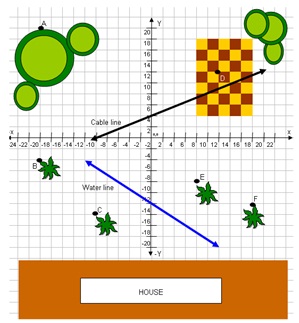Questions:
Landscape Design - Solving Linear Equations
Landscape designers often use coordinate geometry and algebra as they help their clients. In many regions, landscape design is a growing field. With the increasing popularity of do-it-yourself television shows, however, many homeowners are becoming amateur landscape artists.
Suppose you are a homeowner getting ready to sell your home. You realize that there are some landscaping problems that you want to address so that your home will sell quickly and you can get the best price. Since deciding to landscape your backyard, you have realized there are many things to consider, such as budget, time, and space.
Application Practice
Answer the following questions. Use Equation Editor to write mathematical expressions and equations. First, save this file to your hard drive by selecting Save As from the File menu. Click the white space below each question to maintain proper formatting.
1. You are planning to spend no less than $6,000 and no more than $10,000 on your landscaping project.
a) Write an inequality that demonstrates how much money you will be willing to spend on the project.
b) Suppose you want to cover the backyard with decorative rock and plant some trees as the first phase of the project. You need 30 tons of rock to cover the area. If each ton cost $60 and each tree is $84, what is the maximum number of trees you can buy with a budget for rock and trees of $2,500? Write an inequality that illustrates the problem and solve. Express your answer as an inequality and explain how you arrived at your answer.

c) Would 5 trees be a solution to the inequality in part b? Justify your answer.
2. The coordinate graph of the backyard shows the location of trees, plants, the patio, and utility lines. (If necessary, you may copy and paste the image to another document and enlarge it.)
a) What are the coordinates of Tree A? Plant B? Plant C? Patio D? Plant E? Plant F?
b) The water line is given by the equation
Suppose you want to put a pink flamingo lawn ornament in your backyard, but you want to avoid placing it directly over the water line, in case you need to excavate the line for repairs in the future. Could you place it at the point (-4,-10)?
c) What is the slope and y-intercept of the line in part b? How do you know?
d) Suppose you want to add a sprinkler system, and the location of one section of the sprinkler line can be described by the equation
Complete the table for this equation.
e) What objects might be in the way as you lay the pipe for the sprinkler?
